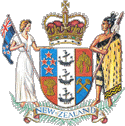Prime Minister of New Zealand
|
|
The Prime Minister of New Zealand is the head of government of the national Government of New Zealand.
| Contents |
Responsibilities and powers
The role of the Prime Minister is not formally defined, being based on constitutional convention rather than specific legislation. According to these conventions, the Prime Minister is leader of Cabinet (itself a body existing by convention), and takes a coordinating role.
The Prime Minister is regarded by convention as "first among equals" — he or she does indeed hold the most senior post in the administration, but is also required to adhere to any decisions taken by Cabinet. The actual ability of a Prime Minister to give direct orders is surprisingly limited — most of the position's power comes about through other means, such as:
- The ability to set the Cabinet agenda, thereby controlling what issues will be discussed.
- The ability to appoint and dismiss ministers. The extent to which this power can be exercised varies between different parties — for example, the Labour Party places most of this responsibility in the hands of the Caucus, leaving the Prime Minister only with the power to choose which portfolios a minister is given.
- The influence a Prime Minister is likely to have as leader of the dominant party — these powers may give him or her more direct control over subordinates than is attached to the Prime Minister's role itself.
- The power gained simply from being central to most significant decision-making, and from being able to comment on and criticise any decisions taken by other ministers.
The Prime Minister also has the ability to call elections by notifying the Governor-General.
By convention, the Prime Minister is the leader of the party or coalition of parties which has the most seats in the houses of the Parliament. There is also a Deputy Prime Minister, who may or may not be from the same party.
History of the office
The exact origins of the office of Prime Minister are disputed. Use of the words "prime minister" as a descriptive term date back to the 1st Parliament, where they are applied to James FitzGerald and Thomas Forsaith. FitzGerald and Forsaith had no official titles, however, and New Zealand had not yet obtained self-rule. As such, they are not usually considered Prime Ministers in any substantive sense.
The first person to be formally appointed to a position of leadership was Henry Sewell, who formed a government at the beginning of the 2nd Parliament. Despite his formal leadership role, however, his only actual title was Colonial Secretary. His successor, William Fox, was also given a formal leadership role, but was not Colonial Secretary. It was not until Frederick Weld, the sixth person appointed to formal leadership, that a substantive leadership title—Premier—appeared. Weld's successor, Edward Stafford, briefly changed the title to First Minister but it was soon afterwards restored to Premier by William Fox. From that point, Premier became the usual designation. Towards the end of the nineteenth century the term Prime Minister arose as a common alternative to Premier and Richard Seddon used the title almost exclusively. Seddon's successor, William Hall-Jones, was officially appointed Prime Minister rather than Premier. The title Prime Minister has been used ever since.
Assuming that Sewell is counted as the first Prime Minister, thirty-seven people have held the office since it was established. Some of these people have held it on several different occasions, with the record for maximum number of times being shared between William Fox and Harry Atkinson (both of whom served four times). The longest that anyone has served in the office is thirteen years, a record set by Richard Seddon. The first holder of the office, Henry Sewell, led the country for the shortest total time; his only term lasted only thirteen days (the shortest term actually belonged to Harry Atkinson, whose third term lasted only seven days, but Atkinson served longer than Sewell in total).
New Zealand is also one of the few countries in the world to have had two female heads of government, and one of only two countries to have two females heads of government directly succeed the other.
List of New Zealand Prime Ministers
External link
- New Zealand Prime Minister's official website (http://www.primeminister.govt.nz/)wa:Djivêye des prumîs minisses di Nouve Zelande

